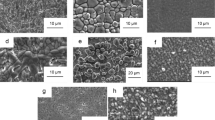Abstract
The blanket is one of the largest and most complex systems in a fusion power reactor. In a D-T fueled reactor the blanket system recovers the energy produced by the fusion reaction and provides for breeding and recovery of tritium for the fuel cycle. The blanket must operate in a severe neutron-radiation, thermal, chemical, mechanical, and electromagnetic environment. Consideration of the required functions of the blanket and the general chemical, mechanical, and physical properties of candidate tritium breeding materials, coolants, structural materials, and so forth, leads to acceptable or compatible combinations of materials. The presently favored candidate structural materials are the austenitic stainless steels, martensitic steels, and vanadium alloys. The characteristics of these alloy systems which limit their application and potential performance, as well as approaches to alloy development aimed at improving performance (temperature capability and lifetime), will be described. Progress toward understanding and improving the performance of structural materials has been substantial. It is possible to develop materials with acceptable properties for fusion applications.
Similar content being viewed by others
References
M.J. Davis:J. Nucl. Mater., 1979, vols. 85 and 86, pp. 1063–72.
D.L. Smith:J. Nucl. Mater., 1984, vol. 122/123, pp. 51–65.
Report of the DOE Panel on Low Activation Materials for Fusion Applications, PPG-728, 1983.
E.E. Bloom, R.W. Conn, J.W. Davis, R.E. Gold, R. Little, K.R. Schultz, D.L. Smith, and F.W. Wiffen:J. Nucl. Mater., 1984, vol. 122, pp. 17–26.
J. W. Davis and G. L. Kulcinski:Nucl. Fusion, 1976, vol. 16, no. 2, p. 355.
R. Benenati, P. Tichler, and J. R. Powell: “Low Activation Aluminum Blanket,” Brookhaven National Laboratory Report NBL-21159, March 1976.
G.R. Hopkins, O. Chawla, E. Cheng, L. Creedon, C. Wong, G. Engle, I. Maya, and K. Schultz: “Low Activation Materials Design Study,” General Atomic Company Report GA-A16426, September 1981.
J.T. Bell, J. D. Redman, and H. F. Bittner:Metall. Trans. A, May 1980, vol. 11A, p. 775.
B.A. Chin, R. J. Neuhold, and J.L. Straalsund:Nucl. Technol., 1982, vol. 57, pp. 426–35.
P. J. Maziasz:Conference Proceedings on Phase Stability During Irradiation, J.R. Holland, L.K. Mansur, and D.I. Potter, eds., Metallurgical Society of AIME, Warrendale, PA, 1981, pp. 477–92.
P. J. Maziasz: Oak Ridge National Laboratory, personal communication.
D.S. Gelles and L.E. Thomas: “Effects of Neutron Irradiation on Microstructure in Experimental and Commercial Ferritic Alloys,”Proceedings of the Topical Conference on Ferritic Alloys for Use in Nuclear Energy Technologies, Snowbird, UT, June 19–23, 1983, J.W. Davis and D.J. Michel, eds., TMS-AIME, Warrendale, PA, 1984, pp. 559–68.
J.M. Vitek and R.L. Klueh: “Microstructure of HFIR-Irradiated 12Cr-lMoW Ferritic Steel,”Proceedings of the Topical Conference on Ferritic Alloys for Use in Nuclear Energy Technologies, Snowbird, UT, June 19–23, 1983, J.W. Davis and D.J. Michel, eds., TMS-AIME, Warrendale, PA, 1984, pp. 551–58.
L. L. Horton and J. Bentley: “Swelling Behavior of a Simple Ferritic Alloy,”Proceedings of the Topical Conference on Ferritic Alloys for Use in Nuclear Energy Technologies, Snowbird, UT, June 19–23, 1983, J.W. Davis and D.J. Michel, eds., TMS-AIME, Warrendale, PA, 1984, pp. 569–78.
W. L. Hu and D. S. Gelles: “Miniature Charpy Impact Test Results for the Irradiated Alloys HT-9 and Modified 9Cr-1Mo,”Proceedings of the Topical Conference on Ferritic Alloys for Use in Nuclear Energy Technologies, Snowbird, UT, June 19–23, 1983, J.W. Davis and D.J. Michel, eds., TMS-AIME, Warrendale, PA, 1984, pp. 631–45.
T. Lechtenberg, D. Cahms, and H. Attaya: “An Assessment of Magnetic Effects in Ferromagnetic Martensitic Steels for Use in Fusion Machines,”Proceedings of the Topical Conference on Ferritic Alloys for Use in Nuclear Energy Technologies, Snowbird, UT, June 19–23, 1983, J.W. Davis and D.J. Michel, eds., TMS-AIME, Warrendale, PA, 1984, pp. 179–83.
M. P. Tanaka, E. E. Bloom, and J. A. Horak:J. Nucl. Mater., 1981, vol. 103/104, p. 895.
B.A. Loomis and D.L. Smith: Swelling of V-15Cr-5Ti Alloy on Single- and Dual-Ion Irradiation,”Alloy Development for Irradiation Performance, Semiannual Progress Report for period ending March 31, 1984, DOE/ER-0045/12, 1984.
D. N. Braski and D. W. Ramey: “A Modified Tritium Trick Technique for Doping Vanadium Alloys with Helium,”Proceedings of the Twelfth Symposium on the Effects of Radiation on Materials, Williamsburg, VA, June 18–20, 1984, F. A. Garner and J. S. Perrin, eds., ASTM STP 870, Metals Park, OH, 1985, pp. 1211–24.
Author information
Authors and Affiliations
Additional information
Research sponsored by the Office of Fusion Energy, United States Department of Energy; in part by Martin Marietta Energy Systems, Inc., under Contract DE-ACO5-84OR21400; and in part by Argonne National Laboratory.
Rights and permissions
About this article
Cite this article
Bloom, E.E., Smith, D.L. Structural materials for fusion reactor blanket systems. JMES 7, 181–192 (1985). https://doi.org/10.1007/BF02833563
Issue Date:
DOI: https://doi.org/10.1007/BF02833563




